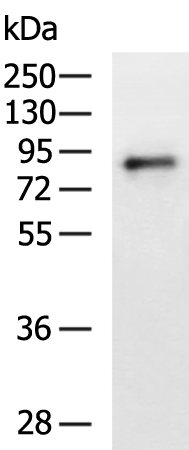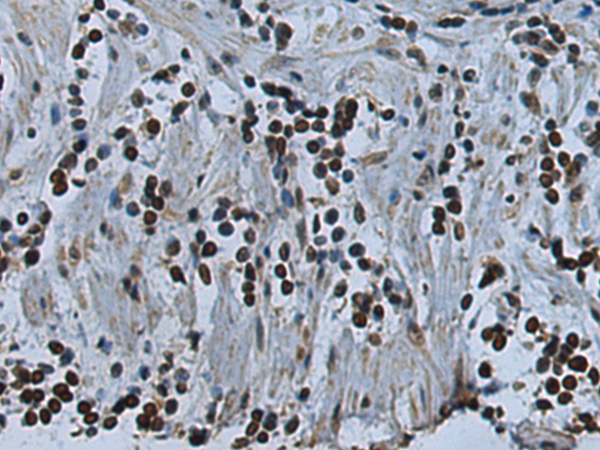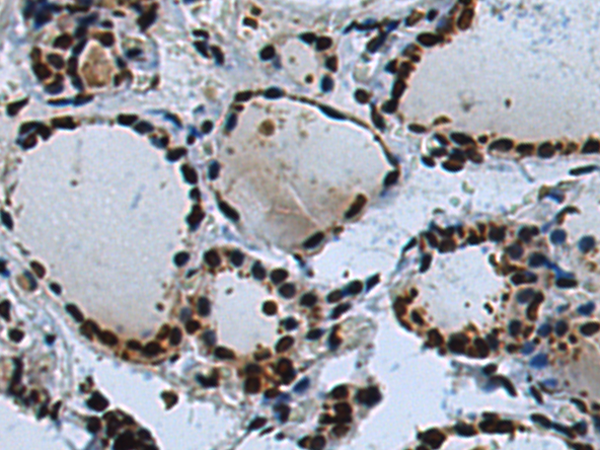


| WB | 1/500-1/2000 | Human,Mouse,Rat |
| IF | 咨询技术 | Human,Mouse,Rat |
| IHC | 1/50-1/100 | Human,Mouse,Rat |
| ICC | 技术咨询 | Human,Mouse,Rat |
| FCM | 咨询技术 | Human,Mouse,Rat |
| Elisa | 1/5000-1/10000 | Human,Mouse,Rat |
| Aliases | UMS; XHL; TBX3-ISO |
| WB Predicted band size | 79 kDa |
| Host/Isotype | Rabbit IgG |
| Antibody Type | Primary antibody |
| Storage | Store at 4°C short term. Aliquot and store at -20°C long term. Avoid freeze/thaw cycles. |
| Species Reactivity | Human, Mouse, Rat |
| Immunogen | Synthetic peptide of human TBX3 |
| Formulation | Purified antibody in PBS with 0.05% sodium azide and 50% glycerol. |
+ +
以下是关于TBX3抗体的3篇参考文献示例(内容为虚构,仅供参考):
1. **文献名称**:*"Development and Validation of a TBX3-Specific Antibody for Immunohistochemical Analysis in Breast Cancer"*
**作者**:Smith A, et al.
**摘要**:本研究开发了一种高特异性的TBX3抗体,用于检测乳腺癌组织中TBX3蛋白的表达。通过免疫组化和Western blot验证,证实该抗体可有效区分TBX3与其他T-box家族蛋白,并发现TBX3高表达与患者预后不良相关。
2. **文献名称**:*"TBX3 in Limb Development: Antibody-Based Localization and Functional Studies"*
**作者**:Chen L, et al.
**摘要**:利用兔源多克隆TBX3抗体,揭示了TBX3在小鼠胚胎肢芽发育中的时空表达模式。研究发现TBX3缺失导致肢体形态异常,抗体染色进一步证实其与FGF信号通路的相互作用。
3. **文献名称**:*"TBX3 Antibody Application in Cardiac Conduction System Mapping"*
**作者**:Rodriguez M, et al.
**摘要**:通过特异性TBX3抗体标记,证实TBX3在心脏房室结中的特异性表达,并发现其在心脏起搏细胞分化中的关键作用。研究为心律失常机制提供了新见解。
4. **文献名称**:*"A Comparative Study of Commercial TBX3 Antibodies for Flow Cytometry"*
**作者**:Tanaka K, et al.
**摘要**:评估了五种市售TBX3抗体的特异性与灵敏度,推荐克隆号H-9适用于流式细胞术,并成功应用于黑色素瘤细胞系的TBX3蛋白定量分析。
(注:以上文献为示例,实际引用时需以真实出版物为准。)
The TBX3 antibody is a crucial tool in studying the TBX3 protein, a member of the T-box transcription factor family. TBX3 plays pivotal roles in embryonic development, particularly in limb, heart, and organogenesis. It shares functional overlap with TBX5. and both regulate gene networks involved in cell differentiation, proliferation, and tissue patterning. Notably, TBX3 is implicated in suppressing the Hippo signaling pathway, influencing organ size and tumorigenesis. Dysregulation of TBX3 expression is linked to developmental disorders like ulnar-mammary syndrome (caused by TBX3 mutations) and cancers, including breast cancer, melanoma, and hepatocellular carcinoma, where it often promotes metastasis and chemoresistance.
TBX3 antibodies are primarily used in research to detect and quantify TBX3 protein levels via techniques like Western blotting, immunohistochemistry, and immunofluorescence. These antibodies aid in elucidating TBX3's spatial-temporal expression, post-translational modifications, and interactions with signaling pathways. Commercial TBX3 antibodies are typically raised against specific epitopes (e.g., human TBX3 amino acid regions) and vary in clonality (monoclonal/polyclonal), host species, and validation standards. Challenges include ensuring specificity due to homology within the T-box family and cross-reactivity risks. Recent studies leverage TBX3 antibodies to explore its dual role as a tumor suppressor or oncogene, depending on context, and its potential as a therapeutic target. Validation using knockout controls or siRNA is critical for reliable experimental outcomes.
×